Celebrate Diversity: “Together We Make Our World Complete”
This Early Learning conference is a collaborative event between Child Care in Practice journal, the Early Years Organisation and the Pasco Hernando Early Learning Coalition
Newry, 15 October 2016
Keynote by Jillian van Turnhout: Evolving Identities in a Changing World
You can download my full speech here: Keynote speech: Evolving Identities in a Changing World
You can contact Jillian via the Contact page on this website.
 Thank you for inviting me to address this conference on ‘evolving identities in a changing world’.
Thank you for inviting me to address this conference on ‘evolving identities in a changing world’.
I had the immense honour of being a Taoiseach’s nominee in the Seanad. My nomination was in recognition of over a decades work on children’s rights across professional, voluntary, and community sectors. Not least as Chief Executive of the Children’s Rights Alliance. My five-year tenure came to an end in April. Many of the issues I have advocated on are definitively over the line, such as the constitutional amendment on children’s rights and banning smoking in cars with children. On many other issues, like the right to identity for adopted people, marriage age, opposition to child beauty pageants, child protection, and the recognition of transgender children, I have been instrumental in laying the foundations and building the bricks for future advocacy over the term of this Government.
 On reflection, the achievement I am proudest of is having championed and secured the
On reflection, the achievement I am proudest of is having championed and secured the
effective ban on the physical punishment of children in the Republic of Ireland. As of 11 December 2015, a person who administers corporal punishment to a child will no longer be able to rely on the archaic common law defence of “reasonable chastisement,” which dates back to 1860. I hope Northern Ireland will follow soon.
 I am also proud to be the Chair of Early Childhood Ireland who represent over 3,500 childcare members who support over 100,000 children and their families through preschool, afterschool and full daycare provision nationwide. Its work includes quality enhancement, publications, advocacy, training, business support and information for a sector that employs 25,000 people today. This does not mean I am an expert in early years care and education, rather my role is to lead the Board in its governance and oversight of the organisation. While I have no doubt that each of you here today can enlighten me on early years issues, I am here to challenge you, to turn a few things upside down and hopefully help us to ensure that early years settings are a place for all children to thrive and achieve their potential.
I am also proud to be the Chair of Early Childhood Ireland who represent over 3,500 childcare members who support over 100,000 children and their families through preschool, afterschool and full daycare provision nationwide. Its work includes quality enhancement, publications, advocacy, training, business support and information for a sector that employs 25,000 people today. This does not mean I am an expert in early years care and education, rather my role is to lead the Board in its governance and oversight of the organisation. While I have no doubt that each of you here today can enlighten me on early years issues, I am here to challenge you, to turn a few things upside down and hopefully help us to ensure that early years settings are a place for all children to thrive and achieve their potential.
Childcare professionals work in early years’ settings and after-school centres, nurturing and harnessing the child’s natural curiosity to explore and to make sense of the world around them. They help lay the child’s foundation skills in science, technology, engineering and maths through the play curriculum. They encourage and inspire children to take their place in society, their community and their circle of friends. To be!
But are we challenging ourselves when it comes to supporting a child to develop their identity and sense of self? I am conscious that there are many aspects and influences to a child’s identity – some of which will be explored by other speakers today. My presentation today will focus on the specific identity issues facing Trans and intersex children, the potential role early years settings can play to ensure a supportive environment and examining how society is increasingly promoting gender stereotyping at younger ages.
My concerns around the rights of trans and intersex children originated through a series of conversations with Tanya Ni Mhuirthile (Lecturer in the School of Law and Government in Dublin City University with expertise in ethics and human rights law, which she considers through the lens of gender, sexuality and law).
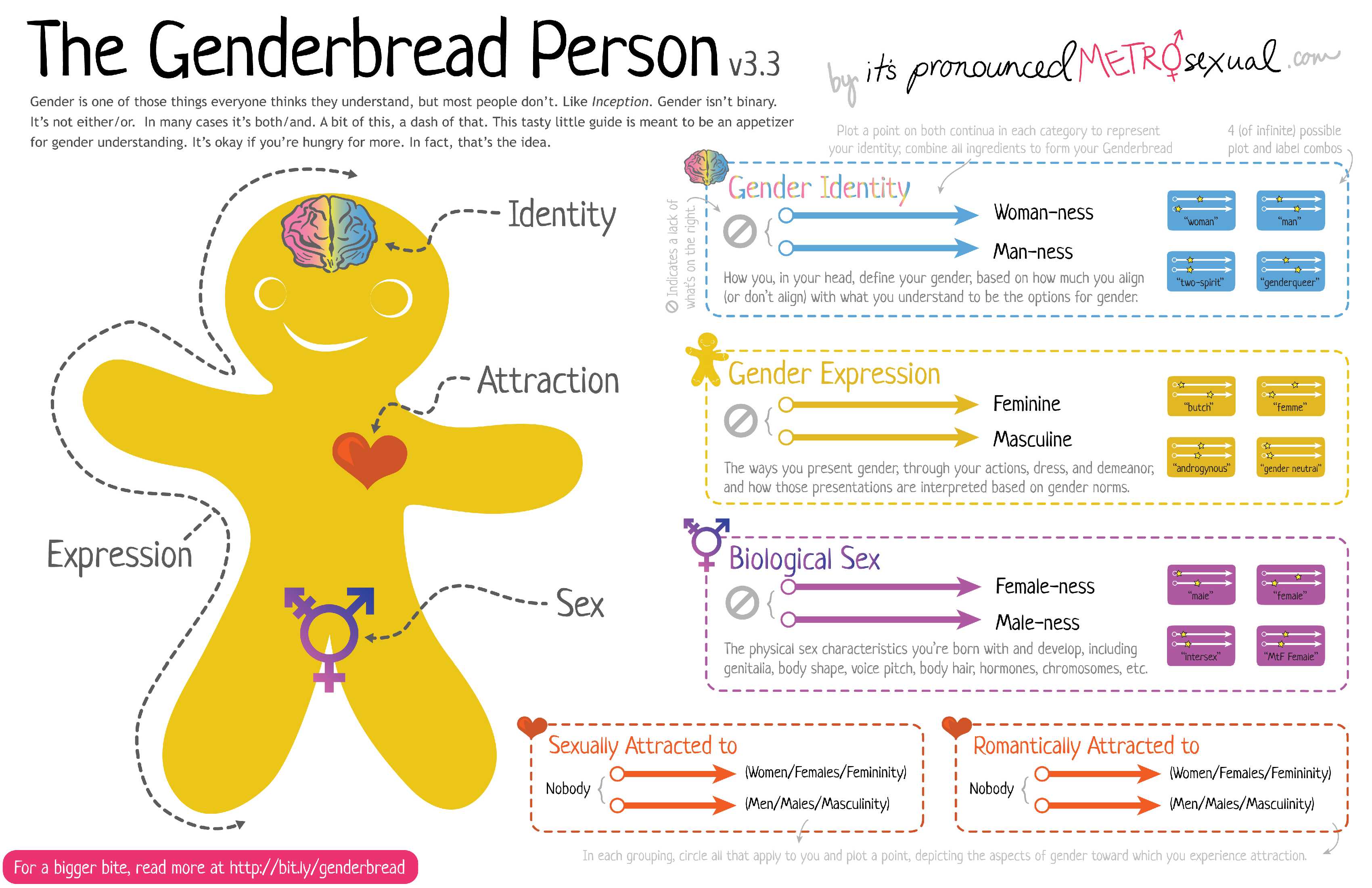
Firstly, let me recommend the Genderbread Person as a great tool to aid your understanding. Let me start by sharing my understanding of the terms and definitions. It is an evolving area with an equally evolving language.
“Gender identity” refers to each person’s internal and individual experience of gender, which may or may not correspond with the sex assigned at birth, including the personal sense of the body (which may involve, if freely chosen, modification of bodily appearance and/or functions by medical, surgical or other means) and other expressions of gender, including name, dress, speech and mannerisms.” So a trans person is one whose gender identity does not match their biological sex at birth.
Tanya’s favourite definition of inter sex was coined by Mirian van der Have and Margriet van Heesh in their presentation to WPATH in Amsterdam this year and goes as follows:
“Intersex is the lived experience of the socio-cultural consequences of being born with a body that does not fit the normative social constructions of male and female.”
This definition is great because it moves the explanation of intersex away from an exclusive biological/medical understanding of the issue and places the huge social and cultural aspects front and centre. However, a more layman’s version of that definition might be:
“Intersex refers to individuals who are born with sex characteristics (such as chromosomes, genitals, and/or hormonal structure) that do not belong strictly to male or female categories, or that belong to both at the same time.”
Gender identity, gender expression, biological sex, and sexual orientation exist independent of one another. In preparing for this today, I have looked for commentary or evidence about the age at which gender identity develops and was struck by the real dearth of research about trans children. In fact, there is no incidence or prevalence data from Ireland or the UK on the number of trans young people under 18. Of the research that was available, I noted that some paediatric specialists put the age of gender identity in children, whether transgender or not, at two or three. Other research cites gender identity development as occurring between three and five years of age.
Elizabeth Reilly et al published a very interesting piece of qualitative research on the issue which solicited the views of transgender adults about the needs of gender-variant children and their parents in the Journal of Sex and Marital Therapy – the peer-reviewed scientific journal published by Routledge – in 2013.
The researchers found that 94% of transgender adults had identified their gender before the age of 18, some 48% had identified their gender between birth and five years of age, while 44% had identified their gender between the age of six and 14. Only 2% identified their gender between 13 and 18 and only 2% after the age of 18, while 4% of the respondents did not reply. That is a pretty good indication of what period of a child’s life is important in terms of gender identification and goes to the essence of what we are talking about here.
On the other hand, sexual orientation and the development of sexual attraction is believed to commence in middle childhood and reach individual subjective recognition sometime around the age of 10 years.
There was a time in Ireland, during the last century, when it was widely believed that people did not become aware of their sexual orientation until they reached adulthood. It was commonly believed that this was something a person decided or determined but thankfully, we are more enlightened as a society now and more understanding of the reality. When it comes to gender recognition, however, we are still back in the last century and that way of thinking. I would like us to understand that it is actually at a much earlier age that one’s gender identity is realised and understood. We need to accept that fact.
(If you would like to find out more why not check out BuzzFeedYellow video on YouTube “What’s it like to be intersex?” http://bit.ly/BFIntersex)
I would like this opportunity to highlight the wonderful work of civil society organisations in the field of LGBT rights and particularly BeLonGTo and TENI, which have a dedicated focus on children and young people.
I am particularly concerned about the mechanisms we need to have in place to minimise the challenges currently faced by trans and intersex children in Ireland. Examples of challenges are the segregated nature of our educational system and the requirement that parents must submit birth certificates for registration to schools. We have a great opportunity in the early years’ sector to have a place where each girl and boy is first and foremost a child.
Can you imagine trying to live your life as another person with a different identity? One might regard oneself as a “she” but be called “he” and be expected to conform by wearing certain clothing.
So, hold this information in your head and let’s play a little game. Please give your instinctive answer and not what you think is the ‘right’ answer.
 I am going to say a word and ask you to yell out the first colour that comes to mind so if I said Apple you would say Green.
I am going to say a word and ask you to yell out the first colour that comes to mind so if I said Apple you would say Green.
– Banana – Yellow
– Fire Engine – Red
– Boy – Blue
– Girl – Pink
We can all understand why yellow and red are associated with bananas and fire engines, but boys are not blue and girls are not pink. So why do we use these colours and associate them with a particular gender?
 I love this quote from 1918, from the trade magazine for children’s clothing, ‘Earnshaw’s Infants’ Department’, “Pink, being a stronger colour is more suitable for a boy, while blue is prettier for the girl.”
I love this quote from 1918, from the trade magazine for children’s clothing, ‘Earnshaw’s Infants’ Department’, “Pink, being a stronger colour is more suitable for a boy, while blue is prettier for the girl.”
In fact, the Ladies’ Home Journal article in June 1918 said, “The generally accepted rule is pink for the boys, and blue for the girls. The reason is that pink, being a more decided and stronger colour, is more suitable for the boy, while blue, which is more delicate and dainty, is prettier for the girl.” Other sources said blue was flattering for blonds, pink for brunettes; or blue was for blue-eyed babies, pink for brown-eyed babies, according to University of Maryland historian Jo B. Paoletti.
 In 1927, the question around gender appropriate colours for boys and girls clothing clearly became a significant issue. Time magazine printed a chart showing sex-appropriate colours for girls and boys following a survey they did with the infants’ departments in major US stores. As you can see the results are mixed.
In 1927, the question around gender appropriate colours for boys and girls clothing clearly became a significant issue. Time magazine printed a chart showing sex-appropriate colours for girls and boys following a survey they did with the infants’ departments in major US stores. As you can see the results are mixed.
It should also be noted that many people completely ignored gender recommendations altogether. In the 1920s many choose neutral colours and then this all changed around the 1940s when clothing manufacturers decided on pink for girls and blue for boys. Perhaps you are thinking well boys simply like blue more and girls like pink more. However, studies trying to see if this is true have come up with mixed results, except for firmly showing that the vast majority of humans prefer blue to pink, and pink is actually one of the adult world’s least favourite colours.
Whatever the case, in the 1960s and 1970s with the age of the women’s liberation movement we saw a resurgence of more unisex or perceived gender-neutral clothing colours. But then along came advancements in prenatal testing and parents could find out the gender of their baby in advance. Once again, manufacturers and retailers started pushing hard for the “pink for girls” and “blue for boys” phenomenon that continues to be entrenched in our society today.
 Here is a photo of my Dad in the centre looking splendid in his dress with his siblings, his Mum and Grandparents.
Here is a photo of my Dad in the centre looking splendid in his dress with his siblings, his Mum and Grandparents.
In the past, not only was there more neutral coloured clothing, children wore white as it was easier to bleach and many wore dresses. Why dresses? Changing nappies is much easier in dresses and with children growing rapidly, dresses were a bit more practical in terms of not needing to get the sizing as precise. Gender differences were not highlighted until children were much older. In fact, it wasn’t at all uncommon to have both boys and girls wear dresses or short skirts until age five or six.
In the early 20th century as I have said this began to change. Beyond the introduction of more colours and loose guidelines around colour by gender, boys started wearing garb associated with men at a younger and younger age, resulting in a shift away from dresses and a move towards trousers. A similar significant shift happened during the women’s liberation movement, but instead of going back to dressing boys in the more convenient dresses, many started dressing their girls the same as boys – in trousers.
 I agree with Jo B. Paoletti when she says “The loss of neutral clothing is something that people should think more about.”
I agree with Jo B. Paoletti when she says “The loss of neutral clothing is something that people should think more about.”
Even things like colouring books are promoted as being for one gender or the other and feature completely different content. Just look at the word magnets with colours to helpfully tell us which is which and the words associated with each gender!! We all know that men can cook and women can drive – and yet we seem ever determined to keep these facts from children.
Or why can’t boys play with dolls? You never know they might even grow up to be fathers!!

In preparation for speaking today, I went on a recce to my local shopping centre to see if what I am saying still holds true… I thought it might take me a few hours to gather suitable material… Whereas, it took only 20 minutes and 5 shops to find enough examples to share with you today.
The first store I walked into was a high street retailer and of course there is a boys’ and
girls’ section. I immediately headed for the under 6s section to find a boys’ T-shirt with a strong statement “I run this city” whereas when I looked at the girls the only statement I could find was “Keep calm and Let it go”.

Perhaps this was just one store and so I headed to another and found a pink Barbie t-shirt with “I woke up this way #selfie”, “be awesome, be beautiful” and “Smile” putting a focus clearly on the girl’s image.

The boys’ section had statements on t-shirts like “Cool”, “Little boys are just superheroes in disguise” and “Hero”. I thought to myself, surely there must be a strong message for girls and so I searched and searched and the best I could find……

…was pyjamas for girls with the message “STAR, Today I feel like a superhero”. Not quite as empowering and definitive!
I then progressed to the toy section. When I was growing up, Lego was the same for us 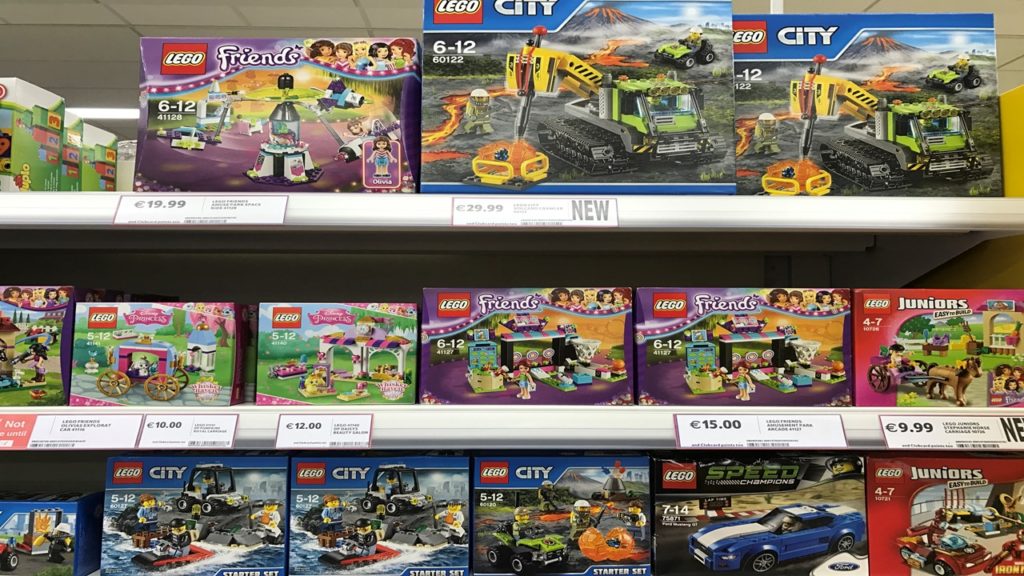 all – some of you will remember the ad from 1981 of the girl in the dungarees proudly holding her Lego. Even though, I know there has been growing discussion and debate about how toys are being targeted I was surprised with the choices I was confronted with on the shelves of my local store.
all – some of you will remember the ad from 1981 of the girl in the dungarees proudly holding her Lego. Even though, I know there has been growing discussion and debate about how toys are being targeted I was surprised with the choices I was confronted with on the shelves of my local store.
The girl lego people on the boxes are ‘princesses’ and ‘friends’. Obviously, the message is that girls don’t need to get involved in building the ‘city’ or ‘speed champions’ since all the pieces on those boxes are boys. Of course, then there is the more obvious “pinkification’ of the toy section.

As the 9-year-old child expresses so eloquently “They have aisles for boys and girls so boys don’t get the wrong things”.
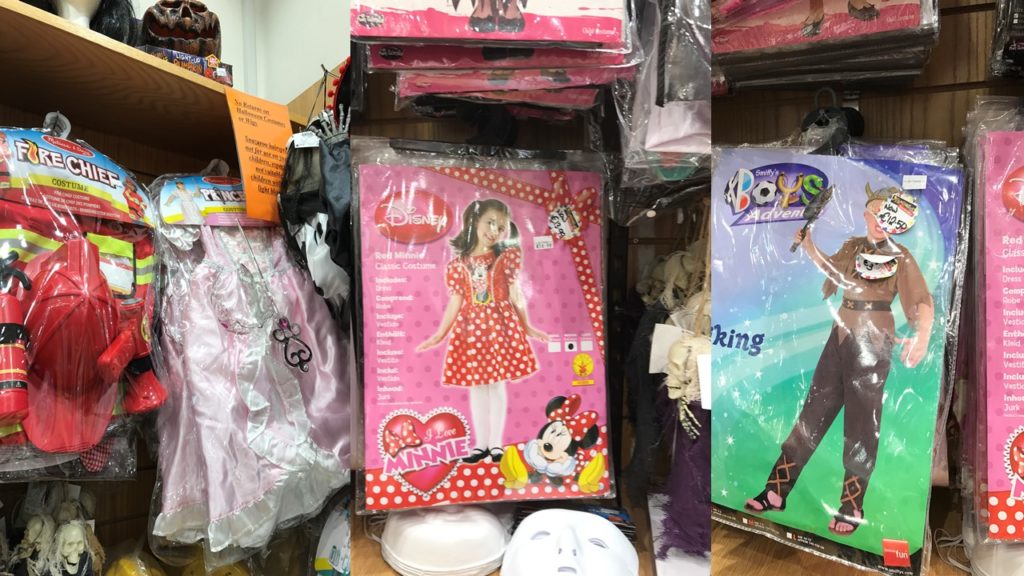
As for Halloween costumes it seems boys should be Vikings and Fire Chiefs and girls are set to be Princesses and Minnie Mouse. Even looking at the posing on the pack it sends out such a strong signal.
Why can’t all costumes be like the Doctor one I saw with both a picture of a boy and girl in green and white. There is hope but we need to question and challenge. We need to complain.
I then headed into a well-known book store and in fairness whilst there was evidence of some ‘pinkification’ it was looking really good until my attention was drawn to two books side by side.
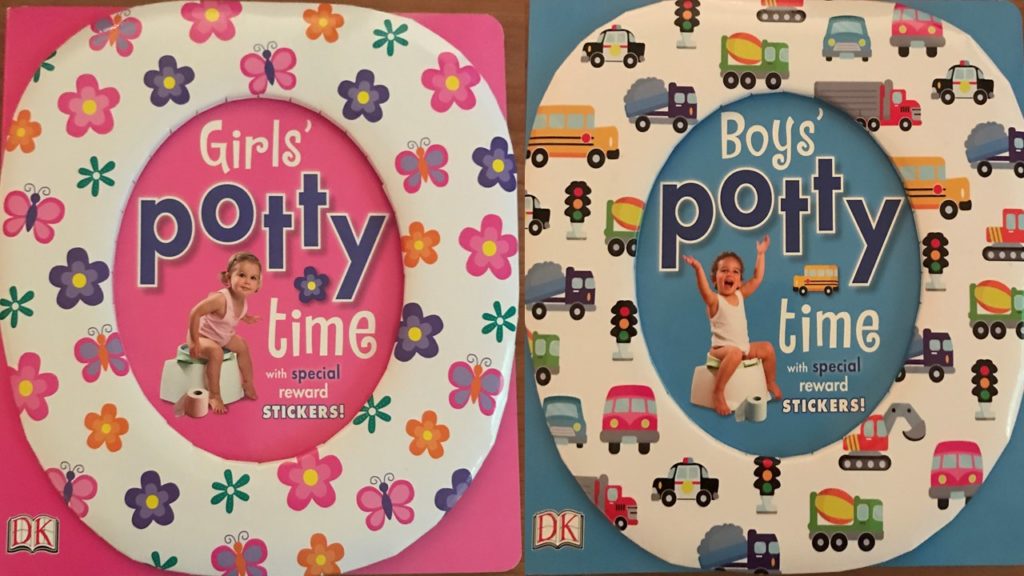 The Books were called “Girls’ potty time” and “Boys’ potty time” and of course by now it will come as no surprise to you all they were in pink and blue respectively. And so I thought, well I am no expert in potty training and so perhaps they have different books due to the differences in anatomy.
The Books were called “Girls’ potty time” and “Boys’ potty time” and of course by now it will come as no surprise to you all they were in pink and blue respectively. And so I thought, well I am no expert in potty training and so perhaps they have different books due to the differences in anatomy.
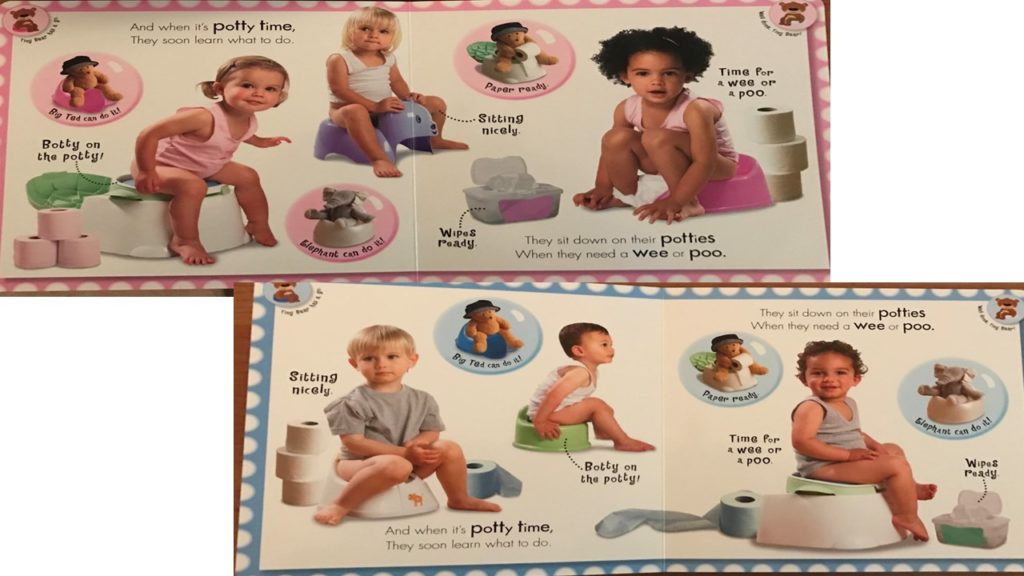
So, I picked up each book and found in its eight pages of hardback the text was the same – the pictures were of girls and boys respectively without any difference in their stance or pose.
Then I spotted the only difference on the opening page – off to the shops, and what did they buy there?
– The girls buy “the prettiest pants”
– The boys buy “the smartest pants”
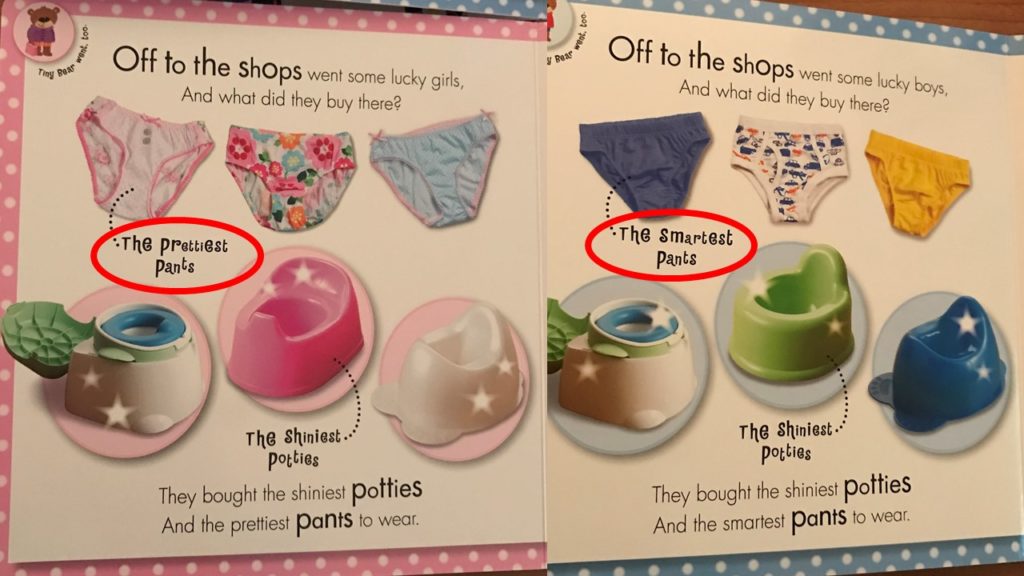 And yet again, we see the socialising of girls to be pretty and the boys to be smart all reinforced with colours. There is absolutely no need for two books.
And yet again, we see the socialising of girls to be pretty and the boys to be smart all reinforced with colours. There is absolutely no need for two books.
We have to be mindful, babies and toddlers can perceive differences in colour from as early as five months and can understand the associated gender stereotypes by the age of two. All children (except the small percentage who are colour blind) learn pink and blue as gender differentiation, which sets them on the path to believing that they are different from their counterparts and that society has different expectations about how they behave. This throws up lots of challenges, not least for the child who does not identify with the perceived norms associated with their anatomical gender.
So, I ask you all in the things you say and the way you act – are you reinforcing gender stereotyping?
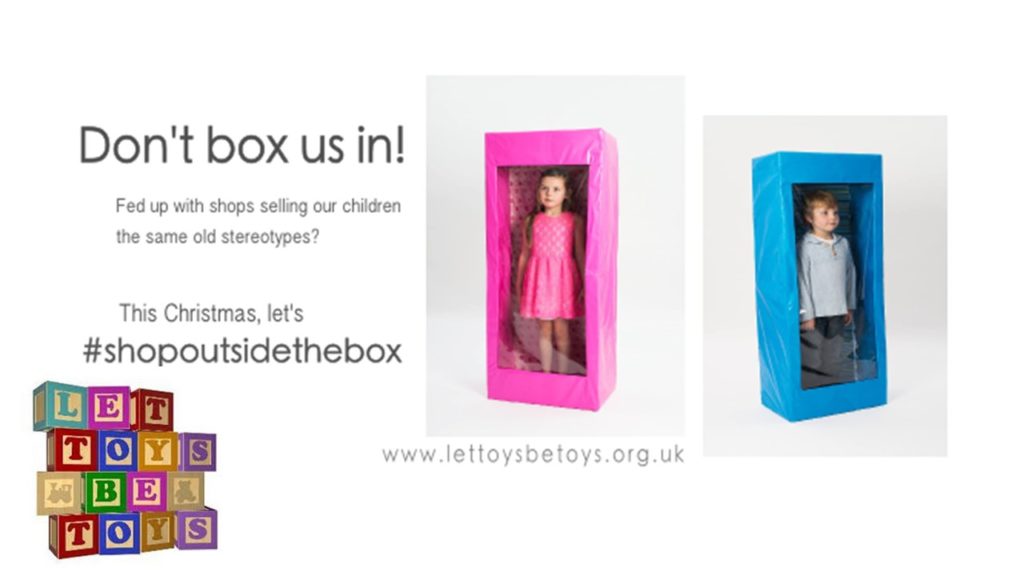 The Let Toys be Toys campaign website is great and offers lots of practical advice such as making small changes towards gender-neutral language like saying ‘children’ instead of ‘girls and boys’ or ‘parents and carers’ or ‘families’ rather than ‘Mums and Dads’, This helps to affirm the things we have in common rather than our differences.
The Let Toys be Toys campaign website is great and offers lots of practical advice such as making small changes towards gender-neutral language like saying ‘children’ instead of ‘girls and boys’ or ‘parents and carers’ or ‘families’ rather than ‘Mums and Dads’, This helps to affirm the things we have in common rather than our differences.
Set examples by asking questions: ‘Why can’t a boy wear pink? My Dad does.’ ‘Why can’t a girl like football? My wife plays for our local women’s team.’ Children are often very keen to ‘police’ one another and make sure their peers follow the gender ‘rules’ they’ve learned. You can set the example by questioning them, and offering counter-examples from your own experience.
The commonalities between boys and girls far outweigh the differences. The evidence for how gender stereotypes impact children is stark and unequivocal. I could spend another hour here talking about how what we are transmitting to children in their early years will affect society, how we socialise, and how we interact later in life.
The gender pay gap (14.4%) remains stubbornly hard to shift, the gender pension gap is growing (37%) and women continue to be under-represented in sectors such as science, engineering and technology. Efforts to recruit men into careers such as teaching especially the early years’ sector has had limited success. As evidenced by 98% of the 25,000 strong early years workforce being women.
Sexual bullying and bullying in relation to sexual orientation and gender identity remain widespread and are closely linked to ideas of how women and men – and boys and girls – are expected to look and behave.
One way to bring about change is to educate children for a world in which such stereotypes need not govern our behaviour and people are free to pursue the lives they want without feeling that certain things are expected of them – or opportunities denied to them – because of either their biological sex or gender expression. As one teacher explained:
“We should be preparing children for the future we hope they will live in – a diverse, non-sexist one. We challenge racism by breaking down stereotypes but we don’t do this anything like as effectively with gender.”
“How many households are there already where the woman is the higher earner – and yet we are not educating them for this very real world.”
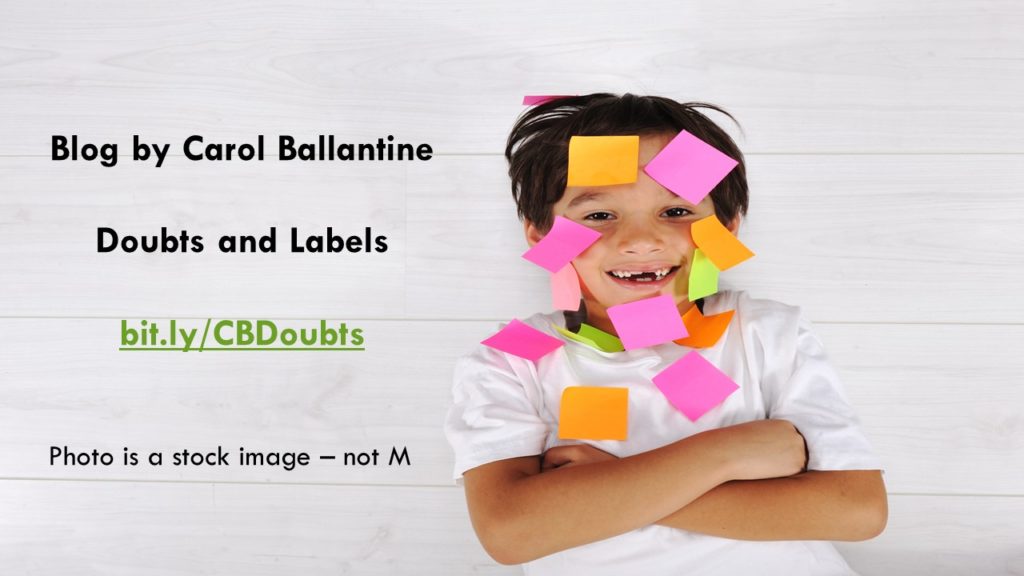 In ending, I would like to share with you a recent blog by Carol Ballantine. I actually know Carol through my volunteering with the Irish Girl Guides and she was happy for me to share some excerpts from her and M’s story today – “doubts and labels” (Full blog bit.ly/CBDoubts).
In ending, I would like to share with you a recent blog by Carol Ballantine. I actually know Carol through my volunteering with the Irish Girl Guides and she was happy for me to share some excerpts from her and M’s story today – “doubts and labels” (Full blog bit.ly/CBDoubts).
“M is nearly six. He looks and acts like a stereotypical girl, but goes by male pronouns. Mostly, I feel confident and even proud of how we’ve navigated this surprising situation — but being me, I’m beset by doubts.
M asks questions I can’t answer. “Will I have a beard when I grow up?” Whenever he makes a wish, he wishes he was a girl. I’m letting him lead — but he’s not quite six, so he’s not great at it. When he leads on a walk we’re likely to end up at the edge of a ravine, kicking up mud and avoiding nettles. How can we offer that without steering him down a track he’s not ready for?
At one stage I thought that we would reach a point where he needed intervention, and then we’d seek intervention from a professional. But when I spoke to a professional, her expert opinion was that M was better off without her. She explained things I’d never thought of, and I’m grateful that she did. Sure, the child needs guidance, but you’re making a very definite statement when the guidance you offer is in a clinic that you have to drive to, and pay for, with a stranger in a rented room (even a lovely room with toys and pictures). It turns a puzzle into an issue, a problem even. And if M didn’t already have a problem, the last thing we should be doing was giving him one.
There is a line between repressing your child on the one side and encouraging them on the other. That line is support — and that’s where you need to be.
We have lots of books that explore difference: we’re well versed in explaining that men don’t have to marry women, that people come in all different colours and abilities, that dogs can do ballet, witches can be friendly, princesses can be tough and boyish, and footballers can also love dancing. But we’ve never quite broached the fact that boys can be girls — or indeed, something else entirely.
I think that M craves a label that fits him, and I’ve been slow to invite him to use the label “girl”. In such a young child, it just feels problematic, because it’s quite true, but not completely true.
Last night, I spotted a new path, a blindingly obvious one maybe, though it had never occurred to me. What if we offer M the label of “transgender”? Something that is real, that shows that there are girls, and there are boys, and there are lots of other types of people, and they all have names. It doesn’t mean that he can’t be a girl — but if that’s what he is, he’ll be that plus trans. Two labels! Awful to an adult — but quite possibly a feast for my child.”
I hope today you will take away and think about what you are doing to inform and 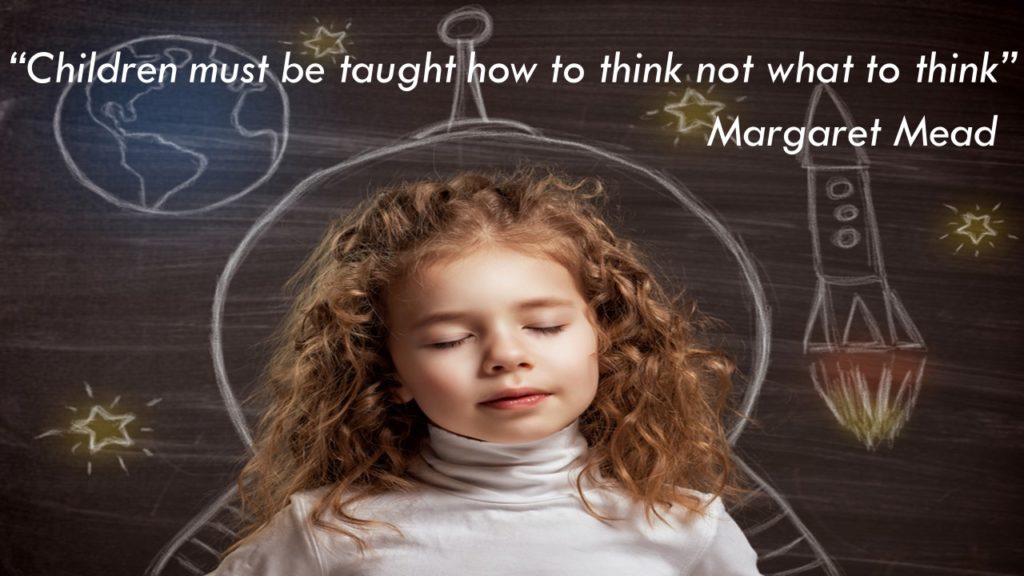 support in the early years of each child’s life. Are you providing a supportive space? Are you willing to confront gender stereotyping as quickly as you would racism? I think we should all remember the very wise words of Margaret Mead “Children must be thought how to think not what to think”
support in the early years of each child’s life. Are you providing a supportive space? Are you willing to confront gender stereotyping as quickly as you would racism? I think we should all remember the very wise words of Margaret Mead “Children must be thought how to think not what to think”
Thank you